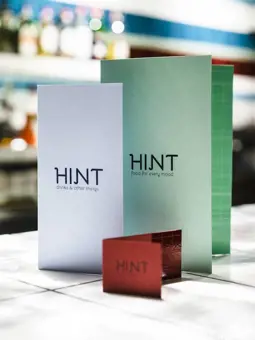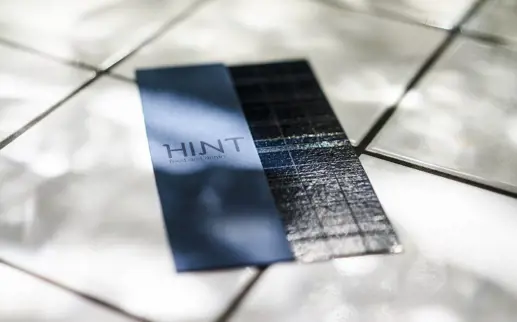PURO Wrocław: HINT Food & Drinks by BUCK.Studio

Where did the HINT idea emerge from? Was it an impulse, a single thought or an aesthetic motif you decided to develop; or was it just the matter of a thorough analysis?
We really took to the PURO “We put U at the centre” philosophy. We like the fact that the brand places so much value on the local context and the character of each hotel’s location. By doing this, PURO makes it possible for guests to feel the local and authentic atmosphere of a city. Searching for the idea that would turn into the new bistro at PURO Wrocław, we focused primarily on the need to identify the less touristy aspects of the city. We wanted to choose one specific element which may not be visible at first glance, but is an interesting point of reference we can use to see Wrocław from a new, more local perspective.
How did you conduct research and search for information and inspiration for HINT? The choice of a marine color palette–shades of blue and green–for the tiles seems surprising. We can say that the colors dominate the interior. Where did this idea come from?
Our research started with a walk; but we didn’t want to reach the Old Town or other tourist attractions. We wanted to delve deeper into the tissue of the city. The eyes of tourists and residents tend to fix on contemporary, effective constructions and renovated yet historic old buildings. Unfortunately, the further you go from the center, the more unkempt and neglected architecture will wait for you.
There is one element, however, that links a lot of these buildings together and speaks for the quality of local architecture as well as the unique history of Wrocław. It is something we can see in the city’s numerous historic old buildings and retail facilities, namely, glazed, colorful tiles. Staircases used to be decorated with them; they covered in-house stoves and, in the form of glazed clinker bricks, were used as parts of the details and finish of buildings. Burgundy, mustard yellow, marine deep blue, azure blue, and bottle green are shades we encounter most often. We chose the ones that complemented the rest of materials in the HINT interior, especially the natural oaken veneer on the walls and furniture.
You specialize in all-round design, i.e. the concept, the architecture, the name, and the communication strategy. Which elements of the HINT concept are your creation?
For HINT, we designed not only its interior, but also its name, staff uniforms, elements of the communication strategy, the logotype, and a whole range of visual identification items, for example the menus, the design of which remains in a visual relation to tiles.




So, what does the name HINT mean?
In English, the word HINT represents a slight or indirect indication; a suggestion. We wanted the name to contain the suggestion that PURO is happy to indicate to its guests the best ways to spend their time in order to really feel the atmosphere of the place they visit. It’s like a hint within a hint :)
Dominika, apart from architecture you also studied food design. Have you finished a lot of restaurant projects? How do you design culinary spaces? Who and what does your intervention reach, who do you cooperate with in the design process? Do you talk to the chef about the menu and to the staff about the ergonomics and space? Do you research (potential) clients, their needs and perceptions of the place? Also, what does food design mean to you – does it introduce new qualities or values?
It’s true we have become specialists in designing culinary concepts and restaurants. The ‘food design’ major is one of the elements of our education. It’s the knowledge of how to change an abstract idea–an interesting culinary/food thought–into a real-life restaurant enterprise. What we consider equally important is practice and experience we want to gain every day. We constantly do our best to find out something new about gastronomy and restaurants. We travel a lot, visit new places, and eat–as simple as that.
Each of our projects is the result of a group work, the dialogue between an investor and everyone else engaged in a project. It is true that we are particularly fond of meeting and working with chefs. A lot of them are truly original human beings with captivating personalities and, very often, inflated egos :) Our task is to create a concept that will serve as a platform where people, food, and space can communicate easily. We talk to and consult everyone who will be responsible for the everyday functioning of a place we design, including the staff. We analyze the profiles of potential clients and try to come up with the best ways to reach them. We check what is missing in the local market or what could be improved. What we don’t do are questionnaires and surveys. We believe that, in the case of original places that need an individual approach, consistency is the most important factor – consistency in how you design the place, how you run it, and how you make it function. This kind of approach allows us to form a group of conscious and loyal guests. We are not interested in survey results and arbitrary individuals who do not partake in the creation of quality we value and stress so much.
You say you design experiences. What does this process look like?
We think that experience design tells the most about what we do. We are architects by profession, but architecture and interior design are just two of the elements that comprise our projects. When it comes to restaurants, it is precisely the all-round experience–not chairs or wall colors–that determines whether we want to come back to a given place and whether we identify with it. As designers of such places, we analyze and plan not only spatio-aesthetic aspects, but also menus, offers, quality-price adequacy, service, name, communication, and visual identification–all the elements and details that create the atmosphere and experience of a specific place.
And how are the places you have created? Do you visit them as guests?
Sure we do! One of our principles is not to design a place we would not like to visit ourselves. As a result, sometimes we have to refuse to work on projects that do not fit our aesthetic. Our designs–often visually simple–are conceptually complex, and we think that their success lies, primarily, in the care for detail. It gives us lots of happiness to see the places designed by us become popular–not only due to a volatile fashion, but because they become characteristic and integral elements of the city’s identity.

Pawła Włodkowica 6
PURO Wrocław
phone 71 772 51 65
opening hours: mon-sun 12-23
photos: interior (1,5): PURO Hotels archives, details (2,3,4,6): PION Basia Kuligowska, Przemysław Nieciecki
*BUCK.Studio - an award-wining Poland based design studio, founded in 2008 by Dominika and Paweł Buck, specializing in hospitality and retail interior design, branding and brand experience in architectural environments.

Similiar Articles

- Trend
- People
- Poland
Lukullus – delicious and beautiful pastries from Warsaw

- Trend
- Art
- People
- News
- Poland
Bielska Jesień – interview with Ada Piekarska, curator of poland's premier painting competition

- Trend
- News
- People
- Poland
